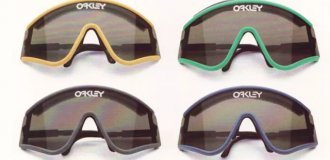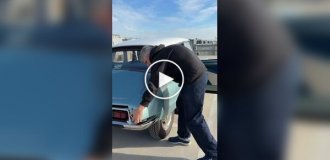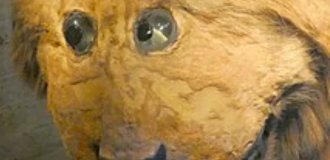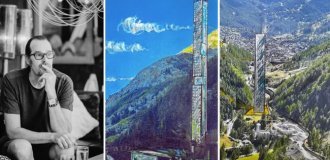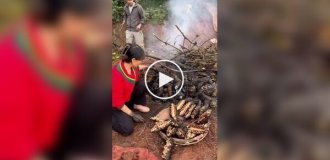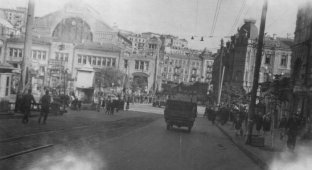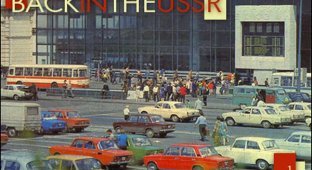Kyiv during the years of German occupation (162 photos)
Very interesting, huge selection of photographs.
Collected and signed them by alex-hedin
Let's see.
Defensive and anti-tank structures near the grocery store at the intersection of Brest-Litovsky Prospekt (now Pobeda Avenue) and 2nd Dachny Lane (now Industrialnaya Street), 1941. Now this place is the location of the Shulyavskaya metro station.
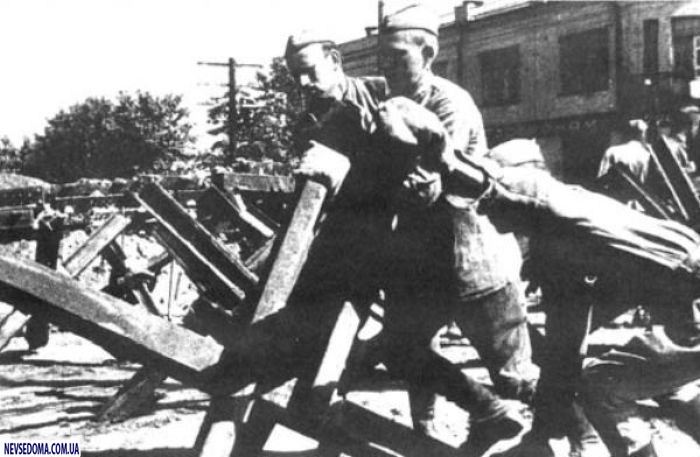
Defensive structures on Lenin Street (now Bogdan Khmelnitsky) near the intersection with Lysenko Street, 1941. To the right of this place is now the Zoological Museum.

Defensive structures on Khreshchatyk Street, 1941. The photo was taken from Bessarabskaya Square. In the center of the photo, on the left side of the street, you can see the high-rise building of the Central Department Store.

Defensive structures at the intersection of Shevchenko Boulevard with Saksaganskogo and Dmitrievskaya streets, that is, in the area of modern Victory Square, 1941.

Burning Bolshevik plant, the result of German bombing, June 23, 1941.

Construction of earthen defensive structures across Lutheranskaya Street in the Khreshchatyk area, 1941.

German armored personnel carrier SdKfz-231, captured by soldiers of the 1st division of the 4th special purpose battalion of the NKVD.

T-26 on the Chain Bridge, then the bridge was called that. E. Bosch, 1941. The chain bridge was blown up in September 1941 by retreating Red Army soldiers and was never rebuilt. The Metro Bridge now stands on this site.

Captured German self-propelled artillery unit StuG-III at the entrance to the opera house, 1941.

The "Sparkling Water" store looted by looters on Khreshchatyk, September 19, 1941. On this day, German troops entered the city.

The destroyed "Red Corner" in Pavlovsky kindergarten at the intersection of Novo-Pavlovskaya and Gogolevskaya streets, September 19, 1941.

German aerial photograph of Kyiv, June 1941. The numbers indicate: 3 - the building of the old Arsenal, 5 - Podolsky railway bridge, 6 - the E. Bosch bridge and its continuation - the Rusanovsky bridge, 7 - the not yet completed wooden Navodnitsky bridge, now in its place is the bridge named after. Patona, 8 - Darnitsky railway bridge.

The first German cars on Khreshchatyk, September 1941. The photo was taken in the Bessarabsky market area. In 1941 there was a grocery store on this site, but now there are several sports stores there.
Interestingly, the German drives the car while sitting on the door, thus improving his visibility. In the hands of some Kiev residents are bags of food, the last thing they managed to take from the destroyed stores.

An Audi car stands in front of house No. 47 on Khreshchatyk Street, at that time there was the National Hotel there, September 1941. The photo shows that the woman has slippers woven from reeds on her feet. The boy on the right is holding a lotto or chess, probably stolen from some store. At that time, no one needed them anymore...

A German motorcyclist on Khreshchatyk, Kiev residents look at him with interest, September 1941. To the right is the TSUM building, in front is Bessarabka. This is a photo from the American magazine "Life" for November 3, 1941.

An old man watches the marching Germans, September 19, 1941.

Wehrmacht reconnaissance unit, September 19, 1941. On the left is the building of the old Arsenal, on the right is the tower of Ivan Kushkin with an embrasure made in it, in the depths you can see the Holy Trinity Gate of the Lavra. On the sidewalk there are the rails of tram No. 20, now in this place there is a trolleybus route No. 20. Photo from Life magazine.

German soldiers on the fourth tier of the bell tower in the Pechersk Lavra. In the background, the unfinished wooden Navodnitsky Bridge is burning; now in its place is the Paton Bridge. Photo from Life magazine.

The photo was taken from the Lavra bell tower. Below is the garden and defensive walls of the Lavra with the tower of Ivan Kushkin, on the right is the old Arsenal (now there is the Ukrainian Historical Center), in the center of the picture is the Church of St. Theodosius of Pechersk, just above you can see the building of shoe factory No. 1 (now there is the Kiev shoe factory) .

A German sentry on the Lavra bell tower, the Navodnitsky Bridge is burning on the Dnieper, September 20, 1941. Photo from the magazine "Volkischer Beobachter".

A satisfied German rings the bells at the Lavra bell tower, September 20, 1941.


German signalman on the territory of the Lavra, September 1941. The bell tower is smoking, it was set on fire by underground fighters or retreating Red Army soldiers. It was only thanks to the efforts of the Germans that the bell tower was saved. On the left you can see the cross on Stolypin’s grave.

Germans in the courtyard of the Upper Lavra near the Trinity Church, September 1941.

Stalin Square (now European Square), September 1941. German columns are moving up Grushevsky Street. On the left is the Public Library (now the Parliamentary Library), in the back is the Museum of Ukrainian Art, a little higher is the building of the Council of People's Commissars (now the Cabinet of Ministers of Ukraine).

German columns are moving towards Pechersk, up Grushevsky Street. The Church building is visible in the background, September 1941.

A German Pak-35 fires from the Mariinsky Park at the Red Army units that have retreated to Darnitsa, September 20, 1941.

Germans on Lipki, September 20, 1941. On the right is the Mariinsky Park, on the left is the House of the Red Army (now the House of Officers), and in the background is the church of the palace ensemble (now in its place is the Kiev Hotel). Photo from the magazine "Volkischer Beobachter".

The Germans inspect the fortifications at the intersection of Zhilyanskaya and Kuznechnaya streets, September 20, 1941.


German patrol on Franco Street. Anti-tank hedgehogs and barrels of water for extinguishing possible fires are visible - all that remains of the retreating Red Army, September 1941.

The Germans deploy an anti-aircraft battery on the observation deck in Pionersky Park (formerly Kupechesky), September 1941. Now in this place is the famous “Friendship of Peoples” arch and the same observation deck.

German troops continue to enter the city, the column moves along Saksagansky Street, this is the block between Pankovskaya and Lev Tolstoy streets, September 1941. To the left of the photographer is the house-museum of Lesya Ukrainka.

Shevchenko Boulevard, in front of the Bessarabian market, September 1941.


Corner of Shevchenko Boulevard and Vladimirskaya Street, behind the photographer is Shevchenko Park. Piles of earth on the sidewalks are obviously the remains of barricades.

The retreating Red Army soldiers completely destroyed the water supply and sewerage systems. In the photograph, German soldiers are getting water - for themselves and for the people of Kiev - at the site of the former Mikhailovsky Golden-Domed Church (now restored). In the background is the building of the Central Committee of the Communist Party (b)U (now the building of the Ministry of Foreign Affairs).

The hay market, which was completely looted during the days of anarchy (September 18-19).

Refugees in the park near the Golden Gate near the well-known cast-iron fountain.

The first order of the German authorities is for all Kiev residents to register and start working. Those who do not register are declared saboteurs and shot. This shoe shiner started working from the first day; the sign says: “Artel “Shishistik”, tray No. 158.”

Railway station, photograph taken in the first days of the occupation. The station was partially destroyed by German air raids and finally by the retreating Red Army soldiers.

Anti-tank ditch and rifle embrasures on Degtyarevskaya Street

Kiev residents dismantle defensive structures on Khreshchatyk, September 21-23, 1941.

Dismantling the barricades on Lenin Street (now Bogdan Khmelnitsky Street). On the right you can see the building of the theater. Lesya Ukrainka.

Residents of Kiev, in the presence of a German field marshal, are clearing away the rubble on Institutskaya Street, not far from Khreshchatyk. On the left are German headquarters buses (the German occupation headquarters was located in the building of the October Palace), on the right are Kiev residents snapping up the first occupation leaflets and newspapers, September 21-23, 1941.

The headquarters building of the Kyiv Military District is occupied by the Germans. Now this building houses the secretariat of the President of Ukraine.

"Timurovites" pose for a German photojournalist, September 1941.

Kiev residents on Khreshchatyk listen to a German radio broadcast transmitted from radio cars, autumn 1941. On the left are houses No. 6-12, on the right - No. 5-7.

The beginning of Shevchenko Boulevard, September 1941. On the left is the Palace Hotel (now the Ukraine). On the transformer booth there is still a Soviet poster “Beat the reptile” and a pre-war advertisement “Enrollment for courses for bookkeepers and accountants.” Over time, the Germans erected a gallows here on which they executed “enemies of the Reich,” and only in 1946 they erected a monument to Lenin on this site.

Poster "Hitler the Liberator" on the facade of the opera house, September 1941. The poster was pasted directly onto pre-war theater posters for the operas "Cossacks beyond the Danube", "Natalka-Poltavka", etc.

Distribution of the newspaper "Ukrainian Word" on the streets of Kyiv, October 4, 1941. The girl on the right has the then fashionable “crown” and “passion curl” braids.

At the entrance to the city.

A German officer poses against the background of St. Andrew's Church, autumn 1941.

The bell tower of the Church of the Intercession on Podol and St. Andrew's Church, autumn 1941.

Contrasts of Soviet reality. The mess at the site of the destroyed St. Michael's Cathedral, on the site of which before the war there was some kind of ATP, and the greatness of knowledge of the Central Committee of the Communist Party of Ukraine (now the building of the Ministry of Foreign Affairs), autumn 1941.

The same yard, children of war.

The lobby of the building of the Supreme Soviet of the Ukrainian SSR, autumn 1941.

Meeting room of the Supreme Soviet of the Ukrainian SSR, autumn 1941. Like the lobby, the hall has remained virtually unchanged. Only the full-length sculpture of Stalin, bas-reliefs of the classics of communism and the coats of arms of the USSR and Ukrainian SSR were removed.

House on the hem, photo of a German officer, autumn 1941. The German was not so much surprised that such a house could stand at all, but rather that people still lived in it... He was not even lazy and went into the yard, where he took another photo. "Socialist realism" through the eyes of a German officer.


Remains of barricades at the intersection of Zhilyanskaya and Kominterna streets, then Vokzalnaya Square and the train station. Busts of Lenin and Stalin hang humiliatingly, probably taken from the nearby Leninskaya Kuznya plant. Below is the index "Feldgend. Zug Doebert" - "Feldgendarmerie. Dobert Platoon".

Dynamo Stadium.

Museum of V.I. Lenin.

Near Askold's grave.

German cemetery, in the distance - Askold's grave.

Red building of Shevchenko University.

Philharmonic building on Stalin Square, 1941.

A gramophone record dealer talks with a German soldier.

Kalinin Square (now Maidan Nezalezhnosti - Independence Square), burned by the NKVD, late September or early October 1941.

Soviet prisoners of war walk along Mikhailovskaya Square, now the Foreign Ministry building, September 1941.

Corner of Khreshchatyk and Proriznaya streets, September 24 - 25, 1941. This is what the center of Kyiv looked like after a farewell gift from the Soviet government.

This and the next photo show German firefighters trying to put out the burning city center.


Bridge named after E. Bosch, blown up by retreating Red Army soldiers, late September 1941.

A dead Red Army soldier, somewhere on the outskirts of the city, September 1941.

The Rusanovsky Bridge was also blown up by the Red Army.

View of Khreshchatyk from Bessarabskaya Square, one of the first explosions and fires, September 24, 1941.

The burning center of Kyiv.

The building of the former National Hotel is on fire.

Ginsburg's destroyed house. The twelve-story building was built in 1912 and was the tallest building in Kyiv for almost 30 years. In the first days of the occupation of Kyiv by the Germans, the house was the underground headquarters of NKVD officer Ivan Kudri, this man led the September bombings of central Kyiv. Ginzburg's house was among those bombed.


Assumption Cathedral of the Kiev-Pechersk Assumption Lavra, November 1941. No comments!


Nauki Avenue in the area of Lysogorskaya Street, autumn 1941. The building at the bottom of the photo still stands on the corner of these streets.

Corner of Melnikov and Pugachev streets, autumn 1941.

Bankovaya Street, autumn 1941 or spring 1942. In the distance, there are several guards at the headquarters building of the Kyiv Military District, occupied by the Germans; now the Secretariat of the President of Ukraine is located there.

The building of the Supreme Soviet of the Ukrainian SSR, late 1941 or early 1942.

Corner of Krasnoarmeyskaya (now Bolshaya Vasilkovskaya) and Zhilyanskaya, autumn 1941. In the photo you can see the preserved trolleybus wires.

Kiev women with Germans.

Corner of Shevchenko Boulevard and current Mykhailo Kotsyubinsky Street, presumably 1942. During the German occupation, Shevchenko Boulevard was called Rovnoverstrasse.

Comintern Street (now Simon Petliura Street), the exact date is unknown. The photo was taken just below the fork at the Shchors monument, with the railway station in front.

Yevbaz (Jewish bazaar) is a place between Shevchenko Boulevard and Brest-Litovsky Prospekt (now Pobedy Avenue), now on the site of the bazaar there is a circus, the house in the background on the right has been preserved, now it houses international ticket offices.

Evbaz, the photo shows a large crowd of people. At that time, people bought, stole, and learned the latest news at the Jewish bazaar.

Another photo of Evbaz.

German postcard from the time of occupation, the blown up bridge named after. Evgenia Bosh.

Photo without caption.

Stalin Square (now European Square), presumably 1942. On the right in the photo is the Philharmonic; on the site of the house on the left there is now a former Lenin Museum.




Temporary crossings built by the Germans, 1942. Now the Dnieper embankment runs here.

Navodnitsky Bridge, 1942.

German signs.

Several orders of the German command were taken from the newspaper "Ukrainian Word" for October 1941.

Grocery store for Volksdeutsche, that is, for ethnic Germans living in the diaspora, Bolshaya Zhitomirskaya Street, 40.

The labor exchange on Smirnova-Lastochkina street, house 20, is the building of the National Art Academy.

Labor exchange, queue for registration.


The queue at the collection point before departure to Germany.

Sending Kiev residents to work in Germany, late 1941 or early 1942.

Propaganda leaflets showing how good it is for Ukrainians to work in Germany. But few of those taken to work were able to share such memories.
More than 150 thousand Ukrainians, mostly young people, were sent from Kyiv and the region to forced labor in Germany.


Hanged Kyivians, somewhere in the center.

Khreshchatyk, Central Department Store building, 1942.

Gonchar Street, house 57, the German headquarters was located here, 1942.

Restaurant "Teatralny", corner of Fundukleevskaya and Vladimirskaya. Sign at the entrance: "For Germans only."

Two more announcements.

Dmitrievskaya Street, Germans are buying something at a spontaneous market.

Hanged Kiev man on Bessarabskaya Square. On the site of the gallows there is now a monument to Lenin.

The executed Kiev residents are piled in a heap.

Park named after Shevchenko, May 1, 1942.

Newspaper "New Ukrainian Word" for May 1, 1942, Kyiv. Original



Newspaper "Last News", Kyiv, 1942. Original

Fence around the Syretsky concentration camp.

Syretsky camp parade ground and barracks.

Barrack window.

Prisoners of war in the Syretsky camp.

Destroyed bridge named after. E. Bosch, winter 1942.

German map of Kyiv, 1943.

Celebrating the second anniversary of the liberation of Kyiv from the Bolsheviks, a German official distributes flags, September 19, 1943.

Bankovaya street.


Sofievskaya Square, 1942 or 1943.

Vorovskogo Street (now Bulvarno-Kudryavskaya), the photographer looks down, towards Yevbaz. These are already German defensive barricades. In October 1943, before the Soviet offensive that led to the liberation of Kyiv, the areas adjacent to the Dnieper were declared a "combat zone", fenced off and evacuated. This photograph was taken by Acme Radiophoto and transmitted by phototelegraph from Stockholm to New York.

German positions on the banks of the Dnieper, 1943.

This photo and the next one show Red Army soldiers crossing the Dnieper near the village of Zarubintsy, Pereyaslav-Khmelnytsky district, October 1943.


Pontoon bridge.

Presumably Svyatoshino, early November 1943. Battle for Kyiv.

Area of Stalin Square (now European Square), early November 1943. The Germans leave the city.



Tankers of the Red Army on "Valentines" move along Khreshchatyk, Kiev residents greet the liberators, November 1943.

Temporary crossing in the area of the E. Bosch bridge built by Soviet troops, November 1943.

Soviet soldiers walk along the street of Kyiv, November 6, 1943. There are mountains of looted things on the sidewalk; the Germans did not have time to take them out.

The surviving Kiev residents return to the city.

Navodnitsky Bridge, not yet restored, 1944.

This and the next photo are the exhumation of corpses in the Syretsky concentration camp.

Hanged collaborators.

Zhukov, Vatutin and Khrushchev.

Zhukov speaks at a rally near the University.

The destroyed building of the factory named after. Bozhenko.

In the photo - Khreshchatyk, blown up by Soviet secret services in 1941. On the right you can see temporary tram rails installed for the delivery of construction materials and garbage removal, 1944.

Work to restore the city.

Construction of a new collector on Khreshchatyk.

Vladimirskaya Street, this is how we rode trams in liberated Kyiv, early 1944.

Sofievskaya Square, late 1943 or early 1944.

German prisoners are led along the central streets of the city, 1943 or 1944.

Khreshchatyk, the first post-war parade in Kyiv, 1945.

